2012 Hyundai Sonata steering
[x] Cancel search: steeringPage 291 of 363
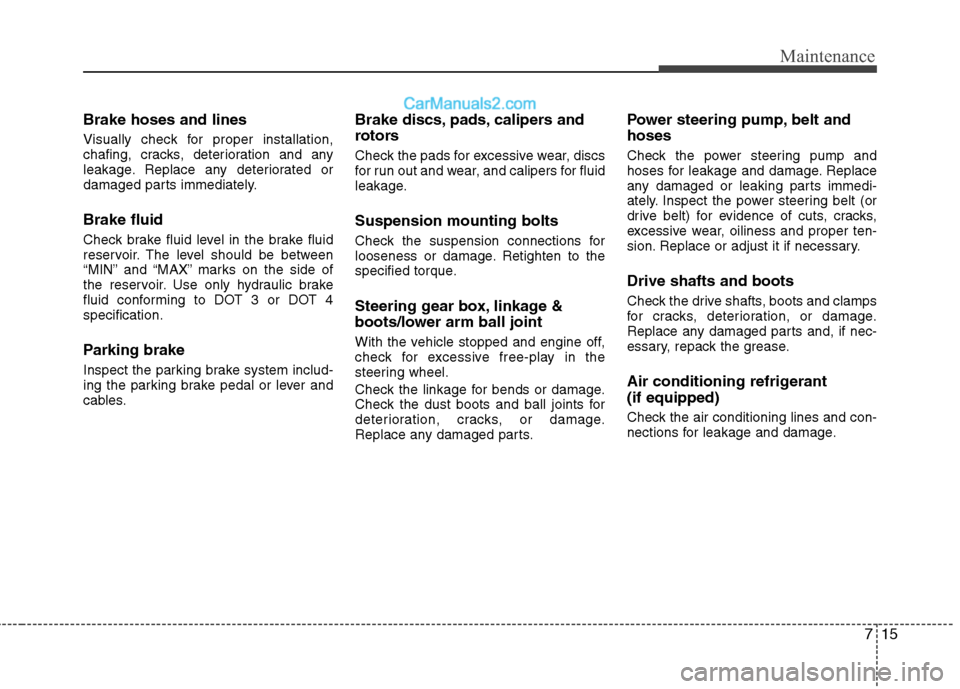
715
Maintenance
Brake hoses and lines
Visually check for proper installation,
chafing, cracks, deterioration and any
leakage. Replace any deteriorated or
damaged parts immediately. Brake fluid
Check brake fluid level in the brake fluid
reservoir. The level should be between
“MIN” and “MAX” marks on the side of
the reservoir. Use only hydraulic brake
fluid conforming to DOT 3 or DOT 4specification.
Parking brake
Inspect the parking brake system includ-
ing the parking brake pedal or lever and
cables.Brake discs, pads, calipers and
rotors
Check the pads for excessive wear, discs
for run out and wear, and calipers for fluid
leakage. Suspension mounting bolts
Check the suspension connections for
looseness or damage. Retighten to the
specified torque.
Steering gear box, linkage &
boots/lower arm ball joint
With the vehicle stopped and engine off,
check for excessive free-play in the
steering wheel.
Check the linkage for bends or damage.
Check the dust boots and ball joints for
deterioration, cracks, or damage.
Replace any damaged parts.Power steering pump, belt and hoses
Check the power steering pump and
hoses for leakage and damage. Replace
any damaged or leaking parts immedi-
ately. Inspect the power steering belt (or
drive belt) for evidence of cuts, cracks,
excessive wear, oiliness and proper ten-
sion. Replace or adjust it if necessary. Drive shafts and boots
Check the drive shafts, boots and clamps
for cracks, deterioration, or damage.
Replace any damaged parts and, if nec-
essary, repack the grease.
Air conditioning refrigerant (if equipped)
Check the air conditioning lines and con-
nections for leakage and damage.
Page 298 of 363
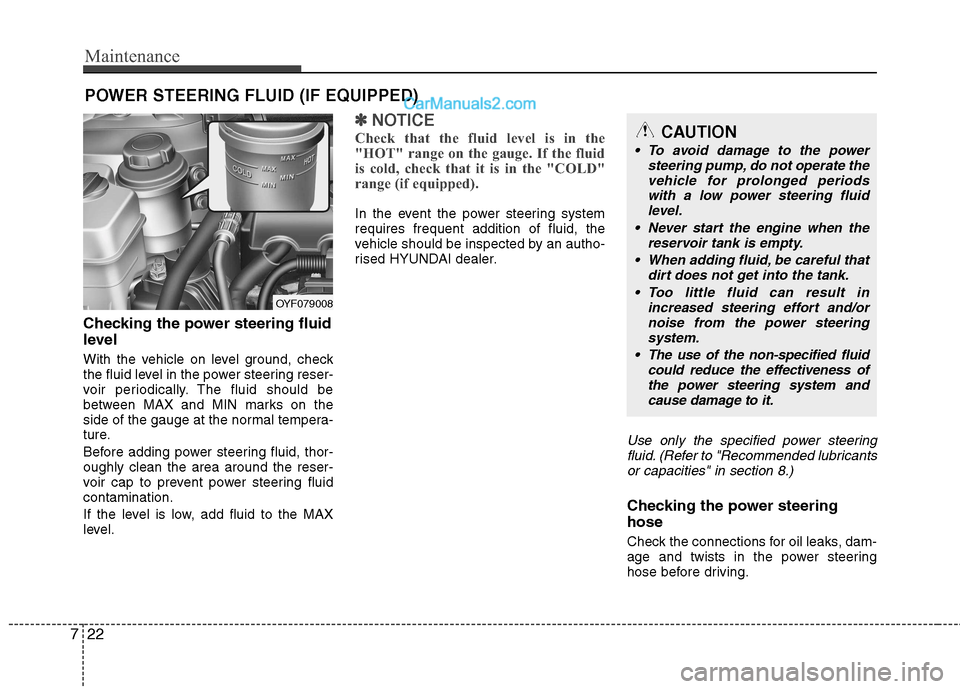
Maintenance
22
7
POWER STEERING FLUID (IF EQUIPPED)
Checking the power steering fluid
level
With the vehicle on level ground, check
the fluid level in the power steering reser-
voir periodically. The fluid should be
between MAX and MIN marks on the
side of the gauge at the normal tempera-
ture.
Before adding power steering fluid, thor- oughly clean the area around the reser-
voir cap to prevent power steering fluidcontamination.
If the level is low, add fluid to the MAX
level.
✽✽ NOTICE
Check that the fluid level is in the
"HOT" range on the gauge. If the fluid
is cold, check that it is in the "COLD"
range (if equipped).
In the event the power steering system requires frequent addition of fluid, the
vehicle should be inspected by an autho-
rised HYUNDAI dealer.
Use only the specified power steering fluid. (Refer to "Recommended lubricants
or capacities" in section 8.)
Checking the power steering hose
Check the connections for oil leaks, dam-
age and twists in the power steering
hose before driving.
CAUTION
To avoid damage to the power steering pump, do not operate the
vehicle for prolonged periods with a low power steering fluidlevel.
Never start the engine when the reservoir tank is empty.
When adding fluid, be careful that dirt does not get into the tank.
Too little fluid can result in increased steering effort and/ornoise from the power steering
system.
The use of the non-specified fluid could reduce the effectiveness ofthe power steering system andcause damage to it.
OYF079008
Page 314 of 363
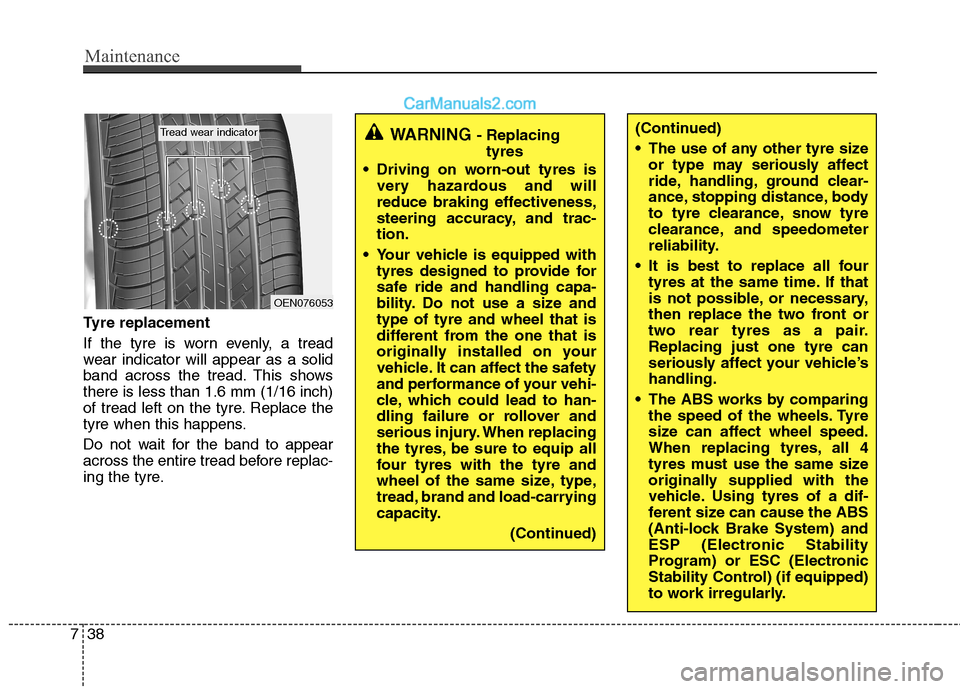
Maintenance
38
7
Tyre replacement
If the tyre is worn evenly, a tread
wear indicator will appear as a solid
band across the tread. This showsthere is less than 1.6 mm (1/16 inch)
of tread left on the tyre. Replace the
tyre when this happens.
Do not wait for the band to appear
across the entire tread before replac-
ing the tyre.
OEN076053
Tread wear indicator(Continued)
The use of any other tyre size
or type may seriously affect
ride, handling, ground clear-
ance, stopping distance, body
to tyre clearance, snow tyre
clearance, and speedometer
reliability.
It is best to replace all four tyres at the same time. If that
is not possible, or necessary,
then replace the two front or
two rear tyres as a pair.Replacing just one tyre can
seriously affect your vehicle’shandling.
The ABS works by comparing the speed of the wheels. Tyre
size can affect wheel speed.
When replacing tyres, all 4
tyres must use the same size
originally supplied with the
vehicle. Using tyres of a dif-
ferent size can cause the ABS
(Anti-lock Brake System) and
ESP (Electronic Stability
Program) or ESC (Electronic
Stability Control) (if equipped)
to work irregularly.WARNING - Replacing
tyres
Driving on worn-out tyres is very hazardous and will
reduce braking effectiveness,
steering accuracy, and trac-tion.
Your vehicle is equipped with tyres designed to provide for
safe ride and handling capa-
bility. Do not use a size andtype of tyre and wheel that is
different from the one that is
originally installed on your
vehicle. It can affect the safety
and performance of your vehi-
cle, which could lead to han-
dling failure or rollover and
serious injury. When replacing
the tyres, be sure to equip all
four tyres with the tyre and
wheel of the same size, type,
tread, brand and load-carrying
capacity.
(Continued)
Page 327 of 363
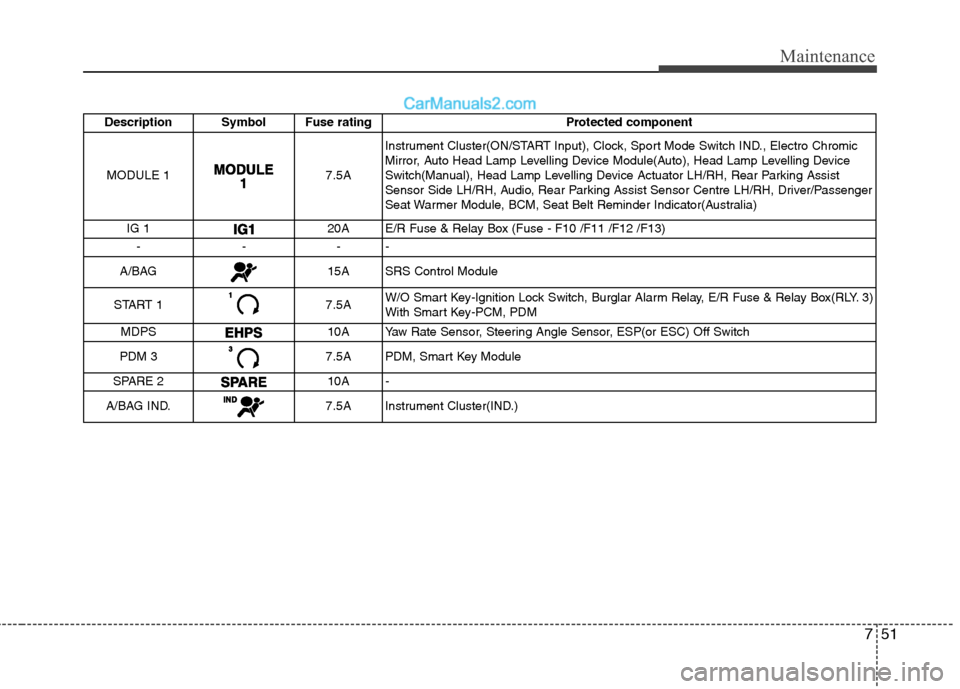
751
Maintenance
Description Symbol Fuse rating Protected componentMODULE 1
7.5A Instrument Cluster(ON/START Input), Clock, Sport Mode Switch IND., Electro Chromic
Mirror, Auto Head Lamp Levelling Device Module(Auto), Head Lamp Levelling Device
Switch(Manual), Head Lamp Levelling Device Actuator LH/RH, Rear Parking Assist
Sensor Side LH/RH, Audio, Rear Parking Assist Sensor Centre LH/RH, Driver/Passenger
Seat Warmer Module, BCM, Seat Belt Reminder Indicator(Australia)
IG 1
20A E/R Fuse & Relay Box (Fuse - F10 /F11 /F12 /F13)
--- -
A/BAG
15A SRS Control Module
START 1
7.5A W/O Smart Key-Ignition Lock Switch, Burglar Alarm Relay, E/R Fuse & Relay Box(RLY. 3)
With Smart Key-PCM, PDM
MDPS
10A Yaw Rate Sensor, Steering Angle Sensor, ESP(or ESC) Off Switch
PDM 3
7.5A PDM, Smart Key Module
SPARE 2
10A -
A/BAG IND.
7.5A Instrument Cluster(IND.)
Page 343 of 363
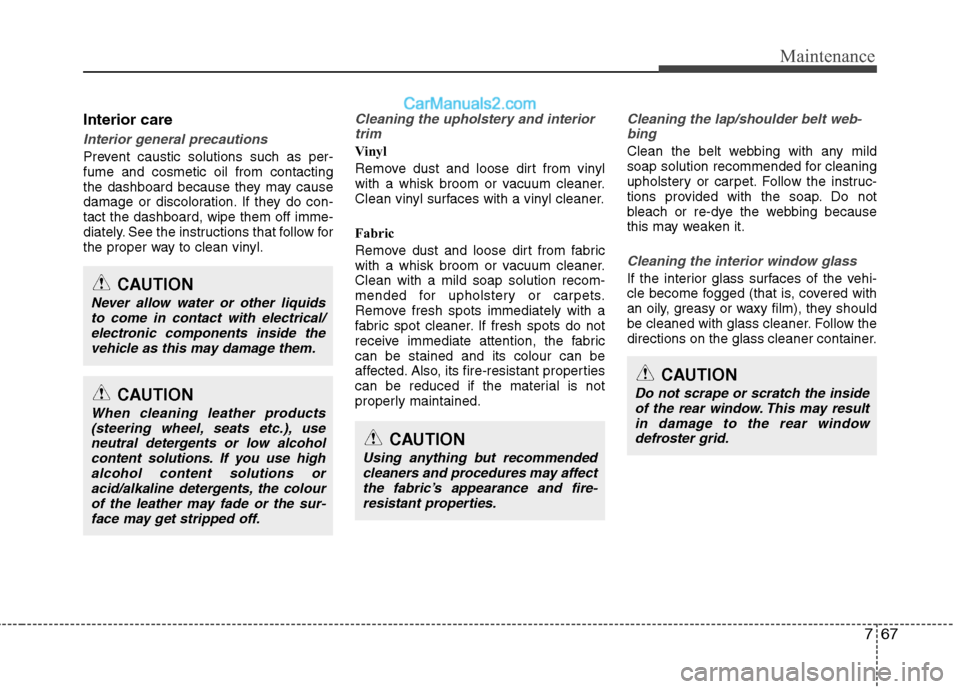
767
Maintenance
CAUTION
Using anything but recommendedcleaners and procedures may affect
the fabric’s appearance and fire-resistant properties.
CAUTION
Do not scrape or scratch the insideof the rear window. This may result in damage to the rear windowdefroster grid.
CAUTION
Never allow water or other liquidsto come in contact with electrical/
electronic components inside thevehicle as this may damage them.
CAUTION
When cleaning leather products(steering wheel, seats etc.), useneutral detergents or low alcohol
content solutions. If you use highalcohol content solutions oracid/alkaline detergents, the colour of the leather may fade or the sur-
face may get stripped off.
Interior care
Interior general precautions
Prevent caustic solutions such as per- fume and cosmetic oil from contacting
the dashboard because they may cause
damage or discoloration. If they do con-tact the dashboard, wipe them off imme-
diately. See the instructions that follow for
the proper way to clean vinyl.
Cleaning the upholstery and interiortrim
Vinyl
Remove dust and loose dirt from vinyl
with a whisk broom or vacuum cleaner.
Clean vinyl surfaces with a vinyl cleaner.
Fabric
Remove dust and loose dirt from fabric
with a whisk broom or vacuum cleaner.Clean with a mild soap solution recom-
mended for upholstery or carpets.
Remove fresh spots immediately with a
fabric spot cleaner. If fresh spots do not
receive immediate attention, the fabriccan be stained and its colour can be
affected. Also, its fire-resistant properties
can be reduced if the material is not
properly maintained.
Cleaning the lap/shoulder belt web-bing
Clean the belt webbing with any mild
soap solution recommended for cleaning
upholstery or carpet. Follow the instruc-
tions provided with the soap. Do not
bleach or re-dye the webbing because
this may weaken it.
Cleaning the interior window glass
If the interior glass surfaces of the vehi-
cle become fogged (that is, covered with
an oily, greasy or waxy film), they should
be cleaned with glass cleaner. Follow the
directions on the glass cleaner container.
Page 350 of 363
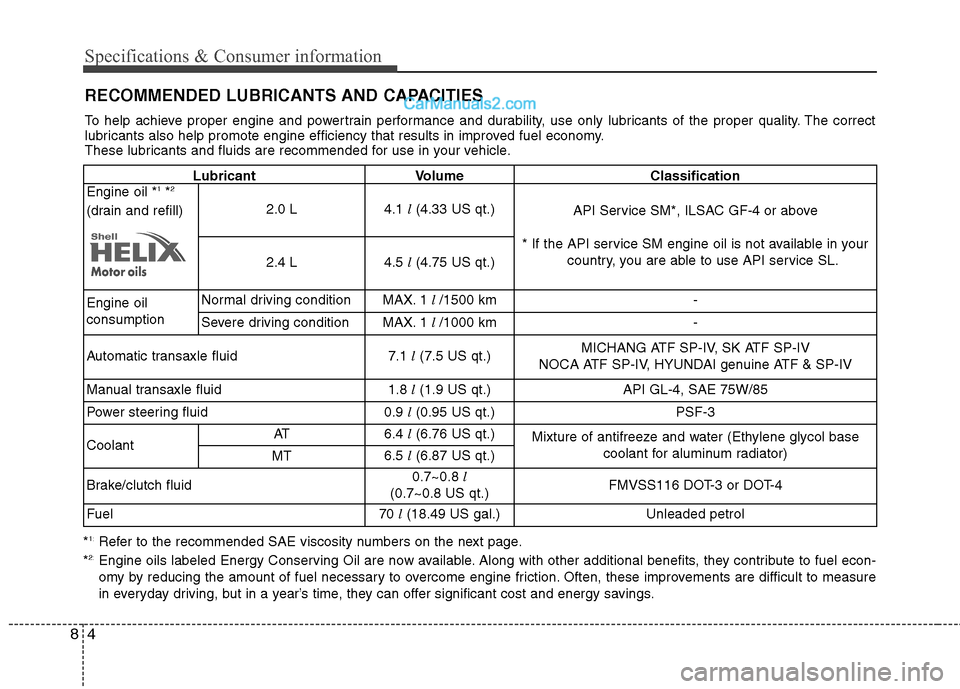
Specifications & Consumer information
4
8
RECOMMENDED LUBRICANTS AND CAPACITIES
* 1:
Refer to the recommended SAE viscosity numbers on the next page.
* 2:
Engine oils labeled Energy Conserving Oil are now available. Along with other additional benefits, they contribute to fuel econ-
omy by reducing the amount of fuel necessary to overcome engine friction. Often, these improvements are difficult to measure
in everyday driving, but in a year’s time, they can offer significant cost and energy savings.
To help achieve proper engine and powertrain performance and durability, use only lubricants of the proper quality. The correct
lubricants also help promote engine efficiency that results in improved fuel economy.
These lubricants and fluids are recommended for use in your vehicle.
Lubricant Volume Classification
Engine oil * 1
*2
(drain and refill)
2.0 L 4.1
l(4.33 US qt.)
API Service SM*, ILSAC GF-4 or above
* If the API service SM engine oil is not available in your country, you are able to use API service SL.
2.4 L4.5 l(4.75 US qt.)
Engine oil consumptionNormal driving conditionMAX. 1 l /1500 km-
Severe driving conditionMAX. 1 l /1000 km-
Automatic transaxle fluid 7.1
l(7.5 US qt.) MICHANG ATF SP-IV, SK ATF SP-IV
NOCA ATF SP-IV, HYUNDAI genuine ATF & SP-IV
Manual transaxle fluid 1.8
l(1.9 US qt.)
API GL-4, SAE 75W/85
Power steering fluid 0.9
l(0.95 US qt.)
PSF-3
Coolant
AT 6.4
l(6.76 US qt.)
Mixture of antifreeze and water (Ethylene glycol base
coolant for aluminum radiator)
MT6.5 l(6.87 US qt.)
Brake/clutch fluid 0.7~0.8
l
(0.7~0.8 US qt.) FMVSS116 DOT-3 or DOT-4
Fuel 70
l(18.49 US gal.)
Unleaded petrol
Page 355 of 363
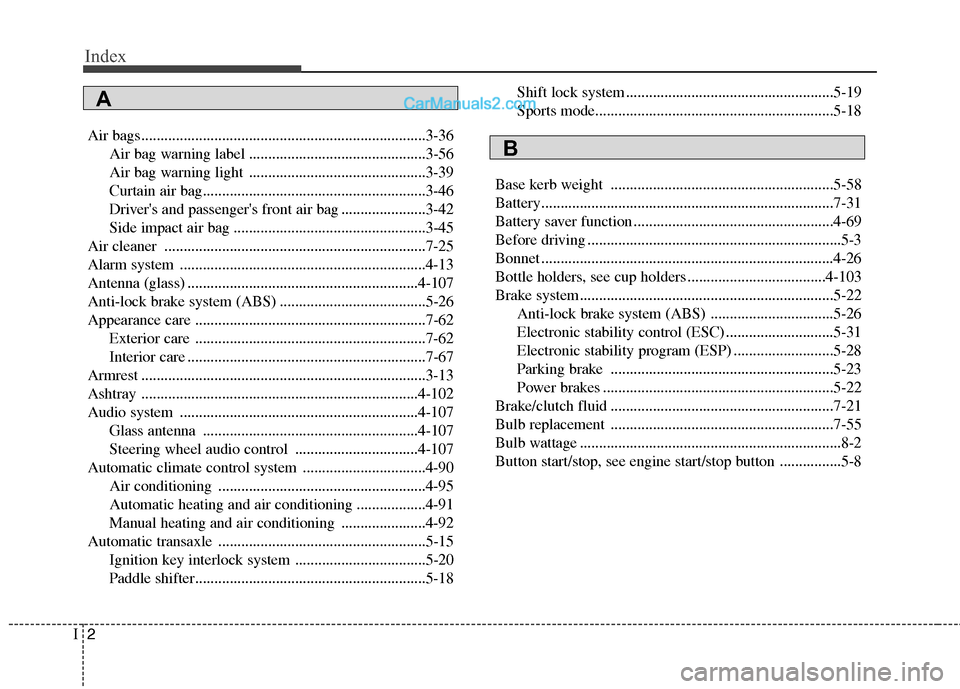
Index
2
I
Air bags..........................................................................3-36
Air bag warning label ..............................................3-56
Air bag warning light ..............................................3-39
Curtain air bag..........................................................3-46
Driver's and passenger's front air bag ......................3-42
Side impact air bag ..................................................3-45
Air cleaner ....................................................................7-25
Alarm system ................................................................4-13
Antenna (glass) ............................................................4-107
Anti-lock brake system (ABS) ......................................5-26
Appearance care ............................................................7-62 Exterior care ............................................................7-62
Interior care ..............................................................7-67
Armrest ..........................................................................3-13
Ashtray ........................................................................4-102
Audio system ..............................................................4-107 Glass antenna ........................................................4-107
Steering wheel audio control ................................4-107
Automatic climate control system ................................4-90 Air conditioning ......................................................4-95
Automatic heating and air conditioning ..................4-91
Manual heating and air conditioning ......................4-92
Automatic transaxle ......................................................5-15 Ignition key interlock system ..................................5-20
Paddle shifter............................................................5-18 Shift lock system ......................................................5-19
Sports mode..............................................................5-18
Base kerb weight ..........................................................5-58
Battery............................................................................7-31
Battery saver function ....................................................4-69
Before driving ..................................................................5-3
Bonnet ............................................................................4-26
Bottle holders, see cup holders ....................................4-103
Brake system..................................................................5-22 Anti-lock brake system (ABS) ................................5-26
Electronic stability control (ESC) ............................5-31
Electronic stability program (ESP) ..........................5-28
Parking brake ..........................................................5-23
Power brakes ............................................................5-22
Brake/clutch fluid ..........................................................7-21
Bulb replacement ..........................................................7-55
Bulb wattage ....................................................................8-2
Button start/stop, see engine start/stop button ................5-8
A
B
Page 357 of 363
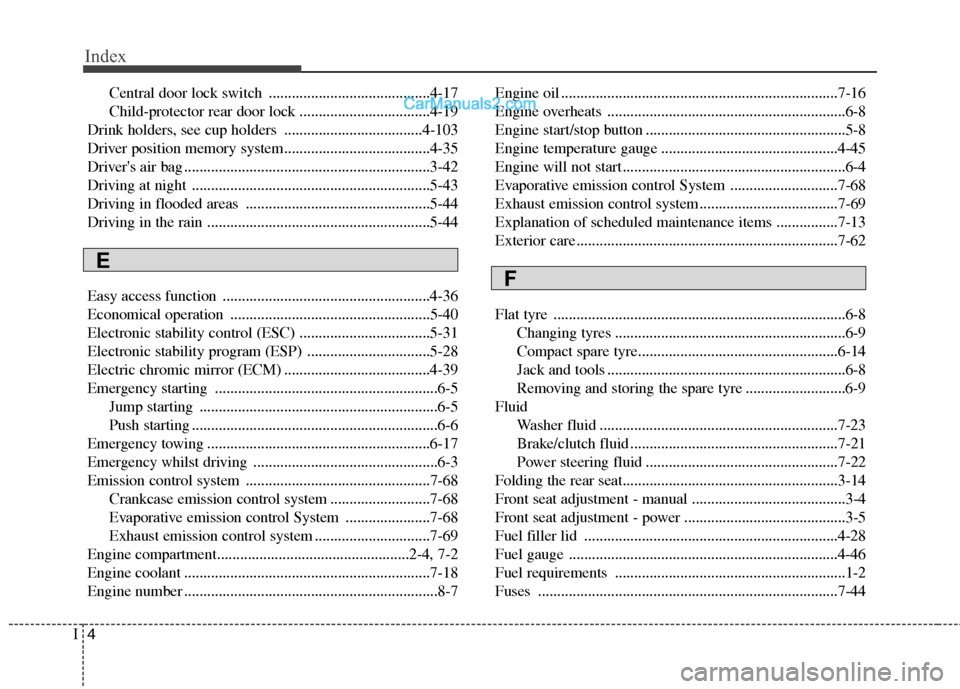
Index
4
I
Central door lock switch ..........................................4-17
Child-protector rear door lock ..................................4-19
Drink holders, see cup holders ....................................4-103
Driver position memory system......................................4-35
Driver's air bag ................................................................3-42
Driving at night ..............................................................5-43
Driving in flooded areas ................................................5-44
Driving in the rain ..........................................................5-44
Easy access function ......................................................4-36
Economical operation ....................................................5-40
Electronic stability control (ESC) ..................................5-31
Electronic stability program (ESP) ................................5-28
Electric chromic mirror (ECM) ......................................4-39
Emergency starting ..........................................................6-5 Jump starting ..............................................................6-5
Push starting ................................................................6-6
Emergency towing ..........................................................6-17
Emergency whilst driving ................................................6-3
Emission control system ................................................7-68 Crankcase emission control system ..........................7-68
Evaporative emission control System ......................7-68
Exhaust emission control system ..............................7-69
Engine compartment..................................................2-4, 7-2
Engine coolant ................................................................7-18
Engine number ..................................................................8-7 Engine oil ........................................................................7-16
Engine overheats ..............................................................6-8
Engine start/stop button ....................................................5-8
Engine temperature gauge ..............................................4-45
Engine will not start..........................................................6-4
Evaporative emission control System ............................7-68
Exhaust emission control system ....................................7-69
Explanation of scheduled maintenance items ................7-13
Exterior care....................................................................7-62
Flat tyre ............................................................................6-8
Changing tyres ............................................................6-9
Compact spare tyre....................................................6-14
Jack and tools ..............................................................6-8
Removing and storing the spare tyre ..........................6-9
Fluid Washer fluid ..............................................................7-23
Brake/clutch fluid ......................................................7-21
Power steering fluid ..................................................7-22
Folding the rear seat........................................................3-14
Front seat adjustment - manual ........................................3-4
Front seat adjustment - power ..........................................3-5
Fuel filler lid ..................................................................4-28
Fuel gauge ......................................................................4-46
Fuel requirements ............................................................1-2
Fuses ..............................................................................7-44
F
E